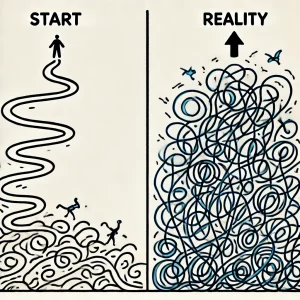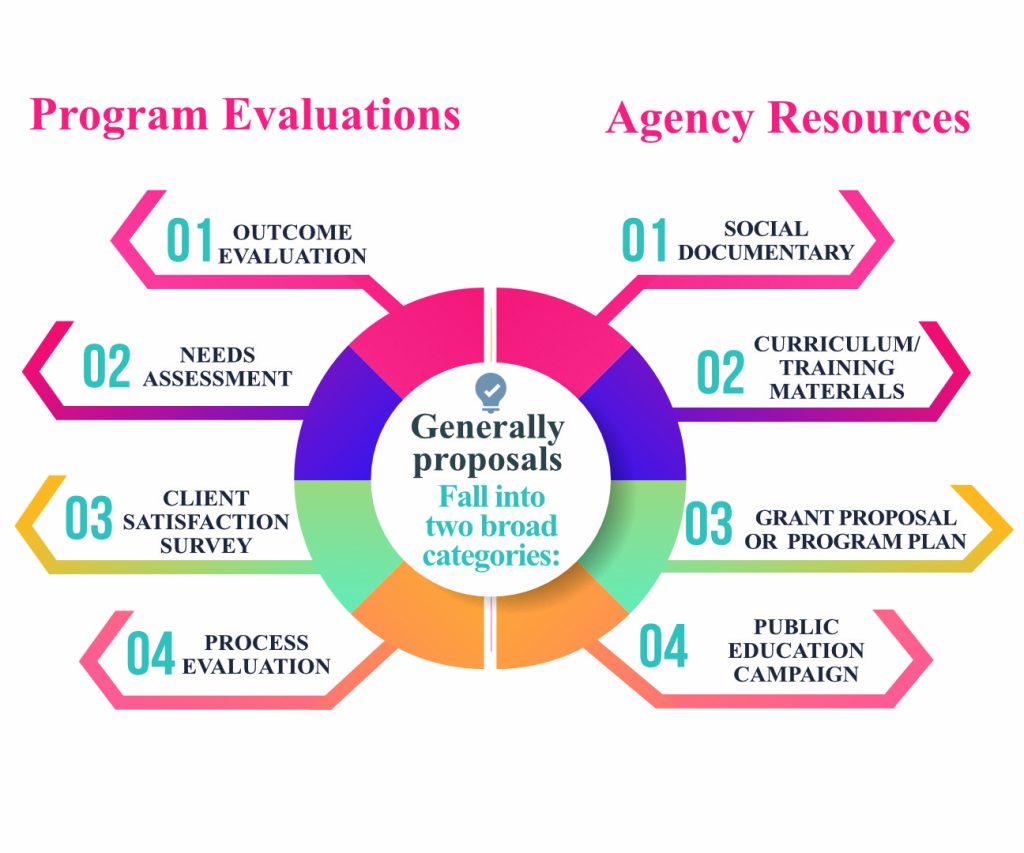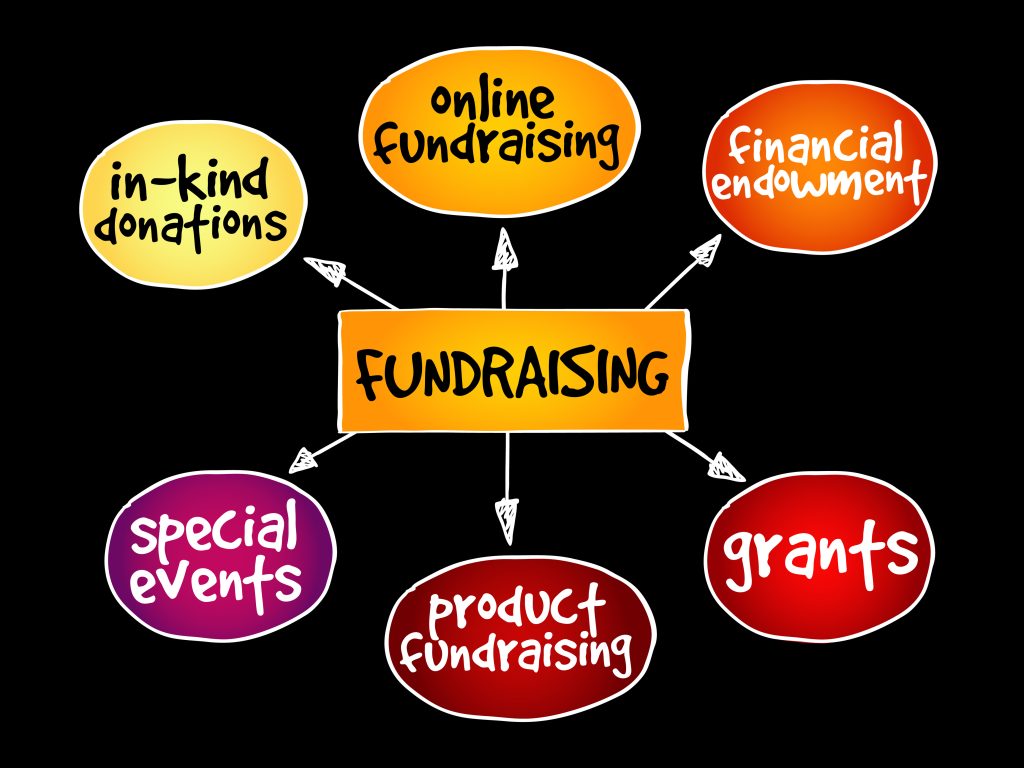1 Introduction to this Guidebook
A Guide to the Proposal Process
Pressbook is compatible with all screen readers, we have worked to ensure that this is an accessible text; however, we encourage you to connect with your instructor if you find any part of the guidebook inaccessible.
Purpose of this guidebook
Creating a culminating project such as a Capstone can bring up a whole host of feelings for students, especially if this is your first experience with self-directed, project-based learning. Anxiety, angst, excitement, pride, confusion, despair, and frustration are common emotional reactions, especially in the earliest stages of this process. While these emotions may at times be disruptive, it’s important to remember that they are typical and mutable.

The process of assessing organizational needs and opportunities, identifying personal learning goals, exploring relevant research, and evolving those complex dynamics into a cohesive proposal requires nuance, patience, and care. As a creative endeavor, the project planning phase is often iterative and non-linear. It is rare for such work to follow a straight line from A to Z. We encourage you – as much as possible – to accept the circuitous nature of developing your Capstone project.
Our purpose in creating this guidebook is to provide guidance and resources that will support your creative process from the beginning assessment and brainstorming stages to the fully developed project proposal that culminates at the end of the semester. By now in your professional studies, you’ve likely developed a hypothetical research study – one in which you determined a research question, analyzed existing evidence, and created a plan for how you would collect and analyze data in line with professional values and ethics. There are a multitude of resources on how to develop a graduate research study. However, resources specific to the development of an agency resource proposal are virtually non-existent. This guidebook is intended to fill this gap; in it we hope to walk you through the process in a paced and scaffolded way.
How to use this guidebook

Think of this guidebook as a roadmap to planning your Capstone project and furthering your professional development goals. Like a map, it allows you to visualize the path to your destination, highlighting “points of interest” along the way. The five chapters that follow correspond to the main sections of the Capstone Project Proposal. Each chapter will provide background information, introduce examples and exercises to help you develop your ideas, and offer tips on crafting your project narrative.
Chapter 1: Introduction to this Guidebook – you’re reading it – provides a general overview of this guidebook and introduces project-based learning and common capstone project types.
Chapter 2: Developing your Purpose focuses on developing your purpose. In this chapter, we will help you explore your learning goals, assess agency needs and opportunities, and determine potential projects. We’ll also offer guidance on identifying the social impact of your project and grounding it in social work values & ethics. Then, we’ll help you translate this thought work into your Statement of Purpose, which serves as the introduction to your project proposal. One final topic of note – this chapter concludes with a short discussion of white supremacy, academic socialization and perfectionism, and how these dynamics might impact the Capstone project.
Chapter 3: Analyzing Research and Writing the Literature Review provides in-depth guidance on assessing relevant research and writing the Literature Review. This chapter begins with a brief discussion of writing as a social work skill. Next, it touches on the types of published research, honing in on peer-reviewed journal articles. It offers tips on identifying relevant research, guidance on writing a theory based literature review, and a discussion of the critical analysis of research, with attention to the concept of multicultural validity. It wraps up with tips on constructing the written review.
Chapter 4: Implementation Planning is all about HOW you will implement your project next semester. Here we walk you through the process of developing your Implementation Plan, including how to identify key action steps, engage collaborators and supporters, incorporate cultural and ethical considerations, operationalize relevant theoretical lenses (such as anti-oppressive practice, participatory principles, and universal design), and develop your positionality statement. It also attends to the unique features of different project types, offering additional considerations specific to grant proposals and program plans, training and curricula, social documentaries, and public education campaigns. We even provide guidance and examples of how to craft a timeline for your project’s implementation.
Chapter 5: Product Description shifts focus to the product itself. At this stage you are offering a brief overview of the intended resource you will offer to the internship agency when all is said and done. For now, this section of the proposal will be short as there’s much you’ll still need to figure out.
Chapter 6: Project Implications summarizes the remaining section of the Capstone proposal. This is the final piece of the proposal and, like the Product Description, will be brief and under-development. This section of the guidebook summarizes what we are looking for – a compelling summary of your project’s importance, discussion of potential limitations of your project, and the anticipated outcomes of your work.
Project-based learning

Given this course’s nature, it is helpful to understand the unique approach of project-based learning and how this type of experiential learning may facilitate your professional development goals. Project-based learning (PBL) is a method of developing knowledge and skills by engaging in real-world practice and problem-solving. PBL is particularly effective in furthering content knowledge, critical and creative thinking, collaboration, and communication skills (What is PBL video overview). Projects are driven by student interest and community or organizational priorities, which helps foster learners’ agency and authentic engagement in professional development.
The framework presented in the image above illustrates the key elements of PBL. To be most effective, projects must be intellectually challenging, real, relevant to practice, and reflective of learners’ authentic interests. They must present learners with genuine choices and opportunities for voice. They should incorporate self-reflection on learning, as well as an intentional process for feedback and revision of project ideas. Finally, they should culminate in a product that can have a real impact and is made available to the community or agency of interest. Taken together, these elements promote deeper understanding, reasoned decision-making, and concrete project management skills that serve learners as they build professional careers in social work.
In making space for learners to develop a project grounded in individualized goals and practice realities this approach fosters learner empowerment and self-efficacy. It also means “class” may look different than a non-PBL course. In PBL courses, educators strive to promote student self-determination and stay out of the way of learning. Educators also intentionally build collaboration with and among students, aiming for a culture of support, encouragement, and constructive feedback. Educators work with students to scaffold and manage learning activities over time. These experiences are designed to translate to contemporary social service workplaces that call for skills in both independent and collaborative work.
For more on project based-learning, check out this short video: The SECRET to crafting Project-Based Learning that Actually Work
Project Types
As you become oriented to the Capstone course, it may be helpful to explore potential project types. Following is a broad overview of projects. More detailed information – including sample student projects – can be found in the Canvas course container, in the Deep Dive Modules.
Generally, proposals fall into two broad categories:

- Program Evaluations – including Outcome Evaluation, Needs Assessment, Client Satisfaction Survey and Process Evaluation
- Agency Resources – such as Social Documentary, Program Curriculum, Training Material, Grant Proposal or Program Plan, and Public Education Campaigns
Program Evaluation Projects use research methods to improve the quality of programs and services at an agency. Learners choosing this project type may examine how programmatic, policy, or community intervention(s) impact clients and client systems. Methodological approaches may include qualitative (interviews, focus groups, etc.), survey, secondary analysis, or group design (pre-post pre-experimental or quasi, experimental, etc.). Examples of projects include:
- a client satisfaction survey for an outpatient drug treatment program,
- a focus group with foster care parents to understand their training and support needs,
- a needs assessment of community safety issues to inform local policy initiatives, and
- a comparison of the impact of animal-assisted group therapy on adolescent mental health treatment with traditional group therapy modalities.
More information on program evaluation projects can be found in the Assignment Description and Deep Dive Module.
Agency Resource Projects attend to organizational dynamics in the development of a project to meet an identified community or organizational need, priority, or issue. There are four common agency resource project types, each described below.

1. Social Documentary
In this project type, learners develop a short media piece to highlight an aspect of the social service organization. The focus could be on agency successes and impact on the community or to raise awareness of an important contemporary social issue. For example, a housing program matching senior citizens with housemates might showcase the social bonds created within this often-isolated population. Alternatively, an intern at a public health prevention program might create a public service announcement about the addictive nature of opioids and alternative pain relief options. Learners opting for this project type may be provided additional support, training, and guidance through a partnership with Metropolitan State University Denver’s (MSU) Department of Journalism and Media Production (JMP). In the Fall semester, JMP faculty are available to provide consultation on what is needed in the proposal. In Spring semester, Capstone students may be partnered with JMP students for technical support with filming and editing their documentary.
2. Program Curriculum or Training Material
In this project type, learners will propose, design and develop program curriculum or training material for their organization. Program curriculum should include a program description, learning objectives, materials, teaching strategies, and lesson plans. A training manual may also include a program description and learning objectives, a discussion of underlying theory, tips for effective implementation and navigating challenges, and additional resources for professional development. Should learners wish to conduct a training for the professional development of staff, interns or volunteers, the training must include the development of resource materials (such as slide shows, videos, infographics, training evaluations, etc.). Examples of projects include but are not limited to a staff handbook on engaging youth in a school-based youth mentoring program, a workshop for foster parents on responding to difficult child behaviors or an 8-week mindfulness curriculum for women experiencing anxiety.
3. Grant Proposal or Program Plan

Learners opting for this project type will design, propose and develop a grant proposal or program plan for organizational use. Proposals should be based on a current program or service offered by the agency; proposals may be targeted to a specific foundation or government funder or be written as a more general template for the organization’s use based on the Colorado Common Grant Application. Students writing a grant proposal will write a cover letter, organizational overview, need statement, program description (goals, objectives, activities and methods), evaluation plan and line-item budget. Examples of projects include but are not limited to a grant proposal to support an on-going job training program for low-income parents, a proposal to fund a new project to engage Latiné youth in civic affairs or a proposal to support a community garden initiative in a neighborhood designated as a food desert.
Program plans are developed when an organization is proposing a new program. The key components of the program plan mirror that of the grant proposal, but the plan is an internal document meant to inform strategic decision-making and organizational development.
4. Public Education Campaign
For this type of project, learners will design, propose, and conduct a public education campaign on behalf of an agency or to raise awareness of a social issue. Such campaigns may include social media, viral challenges, multichannel marketing strategies, and virtual awareness events. Effective campaigns catch the attention of the target audience, inform them of the topic and engage them in action. An example would be the development of social media content, including videos and blogs, to raise awareness of intimate partner violence during Domestic Violence Awareness Month.
Chapter Summary & What’s up Next
In this chapter, we offered an overview of the Guidebook and how to use it. Then we introduced Project-based Learning, as it is central to the Capstone experience. Finally, we provided brief overviews of each project type, hopefully peeking your interest in learning more in the weeks to come.
Up next: developing the purpose of your capstone project. In Chapter 2, you’ll engage in self- and organizational assessments, learn brainstorming tools to assist you in determining project options, and begin to articulate the social impact of your project. This chapter will support you in drafting the Statement of Purpose for your Capstone Proposal.
